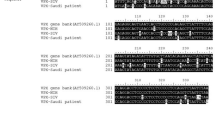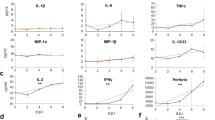Abstract
The nef gene of simian immunodeficiency virus (SIV) is essential for high viral load and induction of AIDS in rhesus monkeys. A mutant form of the SIVmac239 Net which contains changes in a putative SH3-binding domain (amino acids 104 and 107 have been changed from PxxP to AxxA), does not associate with cellular serine/threonine kinases, but is fully active in CD4 downregulation and associates with the cellular tyrosine kinase Src. Infection of two rhesus macaques with SIVmac239 containing the mutant AxxA-Nef caused AIDS and rapid death in both animals. No reversions were observed in the majority of nef sequences analyzed from different time points during infection and from lymphatic tissues at the time of death. Our findings indicate that the putative SH3-ligand domain in SIVmac Nef and the association with cellular serine/threonine kinases are not important for efficient replication and pathogenicity of SIVmac in rhesus macaques.
This is a preview of subscription content, access via your institution
Access options
Subscribe to this journal
Receive 12 print issues and online access
$209.00 per year
only $17.42 per issue
Buy this article
- Purchase on Springer Link
- Instant access to full article PDF
Prices may be subject to local taxes which are calculated during checkout
Similar content being viewed by others
References
Kestler, H.W. et al. Importance of the nef gene for maintenance of high virus loads and for development of AIDS. Cell 65, 651–662 (1991).
Daniel, M.D., Kirchhoff, F., Czajak, S.C., Sehgal, P.K. & Desrosiers, R.C. Protective effects of a live attenuated SIV vaccine with a deletion in the nef gene. Science 258, 1938–1941 (1992).
Du, Z. et al. Identification of a nef allele that causes lymphocyte activation and acute disease in macaque monkeys. Cell 82, 665–674 (1995).
Huang, Y., Zhang, L. & Ho, D.D. Characterization of nef sequences in long-term survivors of human immunodeficiency virus type 1 infection. J. Virol. 69, 93–100 (1995).
Michael, N.L. et al. Functional characterization of human immunodeficiency virus type 1 nef genes in patients with divergent rates of disease progression. J. Virol. 69, 6758–6769 (1995).
Kirchhoff, F., Greenough, T.C., Brettler, D.B., Sullivan, J.L. & Desrosiers, R.C. Absence of intact nef sequences in a long-term, nonprogressing survivor of HIV-1 infection. N. Engl. J. Med. 332, 228–232 (1995).
Deacon, N.J. et al. Genomic structure of an attenuated quasi species of HIV-1 from a blood transfusion donor and recipients. Science 270, 988–991 (1995).
Garcia, J.V. & Miller, A.D. Serine phosphorylation-independent down-regulation of cell-surface CD4 by Nef. Nature 350, 508–511 (1991).
Mariani, R. & Skowronski, J. CD4 down-regulation by nef alleles isolated from human immunodeficiency virus type 1-infected individuals. Proc. Natl. Acad. Sci. USA 90, 5549–5553 (1993).
Skowronski, J., Parks, D. & Mariani, R. Altered T cell activation and development in transgenic mice expressing the HIV-1 nef gene. EMBO J. 12, 703–713 (1993).
Goldsmith, M.A., Warmerdam, M.T., Atchison, R.E., Miller, M.D. & Greene, W.C. Dissociation of the CD4 down-regulation and viral infectivity enhancement functions of human immunodeficiency virus type 1 Nef. J. Virol. 69, 4112–4121 (1995).
Mariani, R. et al. High frequency of defective nef alleles in a long-term survivor with nonprogressive human immunodeficiency virus type 1 infection. J. Virol. 70, 7752–7764 (1996).
Luo, T. & Garcia, J.V. The association of Nef with a cellular serine/threonine kinase and its enhancement of infectivity are viral isolate dependent. J. Virol. 70, 6493–6496 (1996).
Luciw, P.A., Cheng Mayer, C. & Levy, J.A. Mutational analysis of the human immunodeficiency virus: The orf-B region down-regulates virus replication. Proc. Natl. Acad. Sci. USA 84, 1434–1438 (1987).
Hammes, S.R., Dixon, E.P., Malim, M.H., Cullen, B.R. & Greene, W.C. Nef protein of human immunodeficiency virus type 1: Evidence against its role as a transcriptional inhibitor. Proc. Natl. Acad. Sci. USA 86, 9549–9553 (1989).
Kim, S., Ikeuchi, K., Byrn, R., Groopman, J. & Baltimore, D. Lack of a negative influence on viral growth by the nef gene of human immunodeficiency virus type 1. Proc. Natl. Acad. Sci. USA 86, 9544–9548 (1989).
Niederman, T.M., Garcia, J.V., Hastings, W.R., Luria, S. & Ratner, L. Human immunodeficiency virus type 1 Nef protein inhibits NF-kappa B induction in human T cells. J. Virol. 66, 6213–6219 (1992).
Chowers, M.Y. et al. Optimal infectivity in vitro of human immunodeficiency virus type 1 requires an intact nef gene. J. Virol. 68, 2906–2914 (1994).
Miller, M.D., Warmerdam, M.T., Gaston, I., Greene, W.C. & Feinberg, M.B. The human immunodeficiency virus-1 nef gene product: A positive factor for viral infection and replication in primary lymphocytes and macrophages. J. Exp. Med. 179, 101–114 (1994).
Spina, C.A., Kwoh, T.J., Chowers, M.Y., Guatelli, J.C. & Richman, D.D. The importance of nef in the induction of human immunodeficiency virus type 1 replication from primary quiescent CD4 lymphocytes. J. Exp. Med. 179, 115–123 (1994).
Saksela, K., Cheng, G. & Baltimore, D. Proline-rich (PxxP) motifs in HIV-1 Nef bind to SH3 domains of a subset of Src kinases and are required for the enhanced growth of Nef+ viruses but not for down-regulation of CD4. EMBO J. 14, 484–491 (1995).
Lee, C.H. A single amino acid in the SH3 domain of Hck determines its high affinity and specificity in binding to HIV-1 Nef protein. EMBO J. 14, 5006–5015 (1995).
Baur, A.S. et al. HIV-1 Nef leads to inhibition or activation of T cells depending on its intracellular localization. Immunity 1, 373–384 (1994).
lafrate, A.J., Bronson, S. & Skowronski, J. Separable functions of Nef disrupt two aspects of T cell receptor machinery: CD4 expression and CD3 signaling. EMBO J. 16, 673–684 (1997).
Lee, C.H., Saksela, K., Mirza, U.A., Chait, B.T. & Kuriyn, J. Crystal structure of the conserved core of HIV-1 Nef complexed with a Src family SH3 domain. Cell 85, 931–942 (1996).
Myers, G., Korber, B., Wain-Hobson, S. & Smith, R.F. HIVand SIV amino acid sequences. in Human Retroviruses and AIDS. (Los Alamos National Laboratory, Los Alamos, NM, 1993).
Sawai, E.T. et al. Human immunodeficiency virus type 1 Nef associates with a cellular serine kinase in T lymphocytes. Proc. Natl. Acad. Sci. USA 91, 1539–1543 (1994).
Sawai, E.T. et al. Activation of PAK by HIV and SIV Nef: Importance for AIDS in rhesus macaques. Curr. Biol. 6, 1519–1527 (1996).
Nunn, M.F. & Marsh, J.W. Human immunodeficiency virus type 1 nef associates with a member of the p21-activated kinase family. J. Virol. 70, 6157–6161 (1996).
Lu, X. et al. CDC42 and Rac1 are implicated in the activation of the Nef-associated kinase and replication of HIV-1. Curr. Biol. 6, 1677–1684 (1996).
Wyand, M.S., Manson, K.H., Garcia-Moll, M., Monfiori, D. & Desrosiers, R.C. Vaccine protection by a triple deletion mutant of simian immunodeficiency virus. J. Virol. 70, 3724–3733 (1996).
Kestler, H. et al. Induction of AIDS in rhesus monkeys by molecularly cloned simian immunodeficiency virus. Science 248, 1109–1112 (1990).
Ho, S.N., Hunt, H.D., Horton, R.M., Pullen, J.K. & Pease, L.R. Site-directed mutagenesis by overlap extension using the polymerase chain reaction. Gene 77, 51–59 (1989).
Regier, D.A. & Desrosiers, R.C. The complete nucleotide sequence of a pathogenic molecular clone of simian immunodeficiency virus. AIDS Res. Hum. Retroviruses 6, 1221–1231 (1990).
Kirchhoff, F., Kestler, H.W. & Desrosiers, R.C. Upstream U3 sequences in SIV are selectively deleted in vivo in the absence of nef function. J. Virol. 68, 2031–2037 (1994).
Biesinger, B. et al. Stable growth transformation of human T lymphocytes by herpesvirus saimiri. Proc. Natl. Acad. Sci. USA 89, 3116–3119 (1992).
Potts, B.J. “Mini” reverse transcriptase (RT) assay. in Techniques in HIV Research. (eds. Aldovini, A. & Walker, B.D.) 103–106 (Stockton, New York, 1990).
Chackerian, B., Haigwood, N.L. & Overbaugh, J. Characterization of a CD4expressing macaque cell line that can detect virus after a single replication cycle and can be infected by diverse simian immunodeficiency virus isolates. Virology 213, 386–394 (1995).
Skowronski, J. & Mariani, R. Transient assay for Nef-induced down-regulation of CD4 antigen expression on the cell surface. in HIV-1: A Practical Approach. (eds. Rickwood, D. & Hames, B.D.) (Vol. ed., J. Karn) 231–242 (Oxford Univ. Press, Oxford, 1995).
Stahl-Hennig, C. et al. Experimental infection of macaques with HIV-2BEN a novel HIV-2 isolate. AIDS 4, 611–617 (1990).
Author information
Authors and Affiliations
Rights and permissions
About this article
Cite this article
Lang, S., Lafrate, A., Stahl-Hennig, C. et al. Association of simian immunodeficiency virus Nef with cellular serine/threonine kinases is dispensable for the development of AIDS in rhesus macaques. Nat Med 3, 860–865 (1997). https://doi.org/10.1038/nm0897-860
Received:
Accepted:
Issue Date:
DOI: https://doi.org/10.1038/nm0897-860
This article is cited by
-
The KT Jeang Retrovirology prize 2016: Frank Kirchhoff
Retrovirology (2016)
-
Mechanisms of HIV-1 Nef Function and Intracellular Signaling
Journal of Neuroimmune Pharmacology (2011)
-
Determinants in HIV-1 Nef for enhancement of virus replication and depletion of CD4+ T lymphocytes in human lymphoid tissue ex vivo
Retrovirology (2009)
-
HIV-1 Nef associated PAK and PI3-Kinases stimulate Akt-independent Bad-phosphorylation to induce anti-apoptotic signals
Nature Medicine (2001)
-
Apoptosis subversion: HIV-Nef provides both armor and sword
Nature Medicine (2001)



